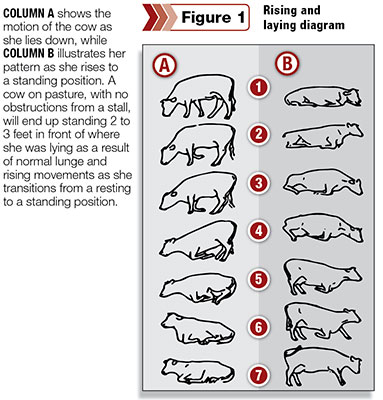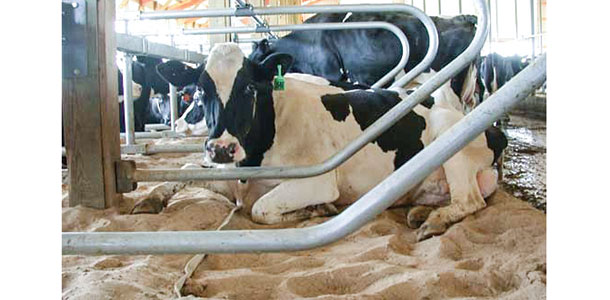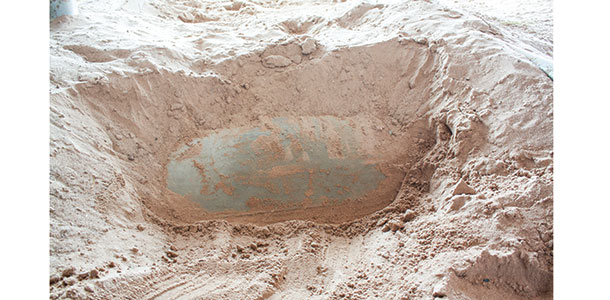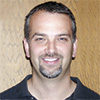Freestall barn design concepts center around optimizing stall occupancy each day while minimizing bed contamination. Four pieces of stall anatomy serve to achieve this by positioning the cow correctly in the stall: the divider loop, neck rail, brisket locator and deterrent wire.
We know that a cow at pasture will end up standing 2 to 3 feet in front of where she was lying as a result of the normal lunge and rising movements of the cow as she transitions from a resting to a standing position.
This is the only modification we are prepared to ask a cow to make when she rises and lies down, by asking her to take a step backward rather than a step forward. She is able to make that compromise as long as we allow all the other lunge movements to occur without obstruction (Figure 1). Thus, the freestall design must promote – not obstruct or deter – the cow’s natural movements.

Divider loop
The divider positions the cow laterally and should suggest “just enough but not too much” of where the cow should lie down. For that to happen, the upper edge of the lower divider rail should be located 12 inches above the rear point of the curb or mattress surface and angled upward 20 to 22 inches behind the brisket locator.
The location of this angle is critical to good cow placement without causing injury. The upper edge of the divider loop determines where the neck rail is located.
Neck rail
The neck rail provides lateral stability to the divider loops and positions the cow in the stall when she is standing (not when she is resting). Most importantly, the neck rail should be high enough for the cow to rise beneath without hitting the underside as she steps back.
Typically, we will locate the rail 46 to 52 inches above the stall surface, necessitating that the internal diameter of the divider loop be approximately 33 to 36 inches. The horizontal placement of the neck rail relative to the rear point of the curb will determine the standing position of the cow in the stall.
In mattress stalls, cows should be allowed to stand straight in the stall, up on the stall platform – typically allowing 68 to 72 inches. The positioning is complicated in deep-bedded stalls because of the raised rear curb – upon which cows do not like to stand.
If the neck rail is located too far forward in deep-bed stalls, the cows will stand diagonally on the stall surface with their feet inside the curb, which results in manure and urine contamination of the bedding.
This situation cannot be managed hygienically, which is why it is necessary that in this type of stall, the neck rail be positioned approximately 5 inches closer to the rear curb, forcing cows to step back out of the stall and “perch.”
We can tolerate this adaptation to stall design with a comfortable, deep, loose bed as cows spend much less time standing in the stall compared to mattress stalls, where perching needs to be avoided.

Brisket locator
The brisket locator helps position the cow relative to the rear curb when she is lying down. When cows rise, they launch their front leg forward to help take their weight. They can lift their leg over a 3-inch-high to 5-inch-high obstacle, but no higher. Without a doubt, a brisket locator higher than 5 inches can be a significant deterrent to stall occupancy – driving reduced lying times and poor cow placement.
For that reason, we have successfully removed brisket locators that presented an obstruction on short stall platforms (8 feet long or less) and improved stall comfort and use. Others have tried to use mounds of bedding as a locator, however, this mound affects the height of the lower divider rail and the neck rail and may impact front lunge.
On stall platforms designed to allow for front lunge (10 feet or more), we have sought other options for a brisket locator to help place the cow, without getting in her way.
For mattress stalls, various plastic and vinyl pipes have been used with some success as long as they sit no higher than 4 to 5 inches above the stall surface. Many of these pipes are too big and too high. In deep loose-bedded stalls, we have come up with an alternative brisket slope – using concrete.
The idea of the brisket slope is that it helps position the cow, while still allowing her to lie with her front leg outstretched, and permits her to plant her front leg on the slope as she rises, pushing her backward in the stall.
This slope is poured and leveled using a form, but most importantly, it is hand-paddled with the correct slope. (Key aspects of design are listed in a sidebar). We have yet to find anything better in this type of stall for cow placement when it is correctly positioned and implemented.
Deterrent wire
The deterrent wire aims to prevent injury by deterring cows from passing beneath the neck rail of head-to-head stalls. It should be a visible obstruction to forward movement when the cow is standing in the stall, but it should be located out of the line of sight when the cow is lying down if we are to avoid it becoming a lunge obstruction.
These deterrent wires are often made of scraper cable, pulled tight with a 3-inch diameter PVC pipe over the top. The lower edge of the obstruction should sit level with the polls of the cows’ heads as they lie comfortably in the stall, which is typically around 38 inches above the stall surface. At this position, they will prevent injury while allowing front lunge.
By understanding how each stall component serves to place the cow, we can build comfortable stalls that remain occupied optimally while keeping the cow clean. PD
Nigel Cook is currently chair of the Department of Medical Sciences at the University of Wisconsin – Madison School of Veterinary Medicine and manages the Dairyland Initiative.
PHOTOS
TOP (FIGURE 1): COLUMN A shows the motion of the cow as she lies down, while COLUMN B illustrates her pattern as she rises to a standing position. A cow on pasture, with no obstructions from a stall, will end up standing 2 to 3 feet in front of where she was lying as a result of normal lunge and rising movements as she transitions from a resting to a standing position.
MIDDLE: With ample space for lunging, a dairy cow can move from resting to standing positions freely and comfortably. Proper placement of the neck rail is key in encouraging her to rise, and the divider loop guides her lateral position in the stall. Photo courtesy of Dairyland Initiative.

Nigel B. Cook
Veterinarian
UW-Madison School of Veterinary Medicine

New brisket slope design adds extra element of cow comfort
The latest recommendation for improving cow comfort in deep sand-bedded stalls is the brisket slope. Dr. Cook walks through the step-by-step process of creating the concrete curve that positions the cow as she rises. This design allows her to stretch a front leg while lying down, as well as stabilize her front leg while pushing backward in the stall to stand.
Instructions for installation of the brisket slope:
1. Pour a rear curb 8 to 9 inches high and either level across the top or sloped slightly towards the bedded area. The curb need only be 6 to 8 inches wide, no wider.
2. Decide how much space the cow requires for resting length. Measure forward from the rear point of the curb the required resting length depending on body size. We suggest the following range for Holstein cows: 66 to 72 inches for 1,300-pound to 1,600-pound cows.
3. Identify the starting and ending point of the brisket slope arc by marking two points:
Pictures of the installation process can be found on the Dairyland Initiative website.
- Identify the point 1 inch below the highest point of the rear curb.
- Identify the highest point of the brisket slope 3.5 inches (9 cm) above the highest point of the rear curb.
4. Draw a smooth arc connecting the two points from A to B – shallow enough for a cow to safely land her front foot on the slope as she rises in the stall. The distance between A and B should be around 10 inches. Draw this out on the concrete wall of a cross alley or an end wall.
5. Locate a wooden form to create the vertical brisket edge and hold the concrete in place as it is poured. Make sure to measure the correct distance from the rear curb – measure to the concrete, not the form.
6. Create a wooden form to shape the concrete as it is poured into the brisket area using the wall drawing as a template. Drag the form across the concrete as it is poured to shape the brisket.
7. Paddle the concrete into a smooth slope before it sets and set any stall divider supports that need to be anchored.






